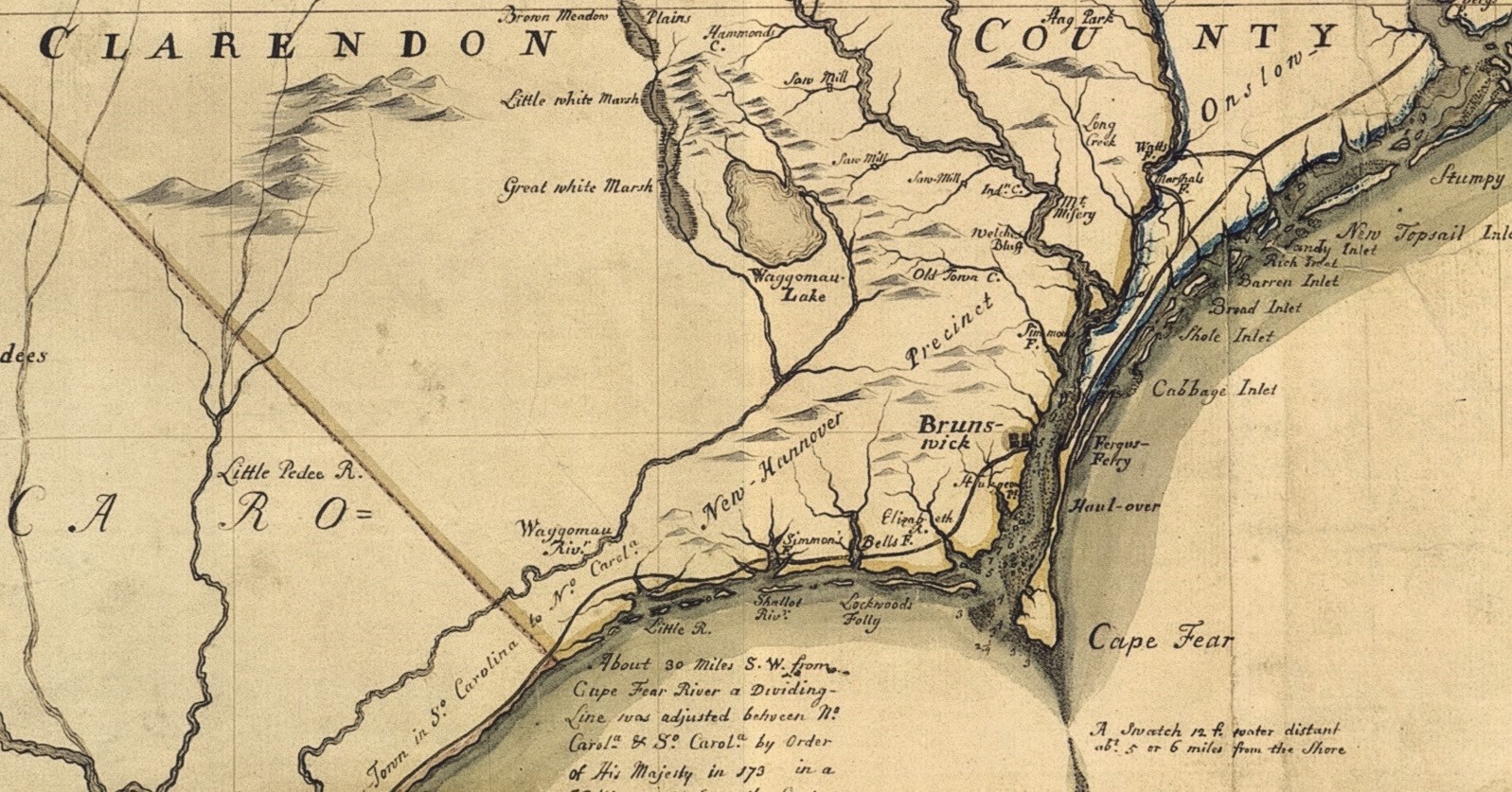Why the name Bald Head Island?
The word “head” is simply short for “headland,” which is a high point of land visible from the sea. In lieu of GPS and electronic navigation, mariners would map out heads and use them for wayfinding. Although it’s called Nags Head, mariners were referencing what we know as Jockey’s Ridge. Perhaps the head on our Island was not quite as large as Jockey’s Ridge; however, it was distinct enough for mariners to reference it. It is likely the head has since been overtaken by the ocean or river. Thus, the “head” part of the name is easy to trace. The “bald” part, on the contrary, has a little murkier origin.
The most-accepted answer among historians concerning the origins of the “bald” part of our name goes back to a group from Massachusetts who came here in 1662 or 1663. The “Committee for Cape ffaire,” also known as the “Adventurers about Cape Fayre,” were a small group of settlers who attempted to make Bald Head Island their home. Maybe they were drawn to the Island by the beaches, the palmettos or the bountiful fishing that brought them here. After a couple of months, however, they decided they “disliked the harbor and the soil” and left the Island.
Also of note, the “Lords Proprietors” back in London abandoned the Massachusettsans’ claim for settlement and instead gave the land over to a group of Barbadians who at that time made the settlement illegal. Nonetheless, they left behind pigs and cattle on the Island, hoping to eventually reclaim them. Slowly but surely, the transplanted livestock ate the vegetation from that headland for years until the head was left bald. Hence the name, Bald Head Island.
Thank you to Jake Grossman, Educator and Collections Coordinator at the Old Baldy Foundation. This text was reproduced in part from his June 2024 Island Report article.

Located at the mouth of the Cape Fear River, Bald Head Island ends where the treacherous sand bars known as Frying Pan Shoals begin. Large sand bars seasonally emerge from and subsequently retreat into the sea. It is thought that Bald Head Island emerged from one such sandbar, stabilized by the establishment of plant life, creating a permanent island.
Over 400 years ago, Native Americans were fishing and hunting in the creeks, forest and on the shoreline of the Cape Fear River. Midden sites (shell mounds) have been found near the creeks, documenting the Indians' presence and reliance on the abundant shellfish. Unfortunately, disease and war killed most of the population before much was learned about the original inhabitants.
In 1524, explorer Giavanni da Verrazano reached what is thought to be the Cape Fear River. He was followed by Lucas Vasques de Ayllon and Sir Walter Raleigh, but attempts to colonize the Cape Fear during the 1600s, were unsuccessful. During that period, the area was called Cape of Feare.
In the 1660s, William Hilton initiated an expedition called the “Adventures of Cape Fayre” by English Puritan dissidents. Sandy, barren soil made farming impossible and colonization efforts were abandoned. Hilton tried again in 1667, but efforts were again foiled.
In 1713, the authorities in North Carolina issued a land grant to Thomas Smith for Cape Island, which was then renamed Smith Island.
Many pirates found refuge in the island's back creeks, the most locally famous of which was Stede Bonnet, known as the “Gentleman Pirate.” Originally a plantation owner from Barbados, he purchased a sloop named Revenge, outfitted it with guns and a crew, and set sail along the East Coast. He sailed as partner to Blackbeard for a time. He was captured and hung in 1718.
In 1776, the British left a small garrison of troops and a few naval vessels to keep the Cape Fear port closed to Continental shipping. They created Fort George on the southwestern corner of Bald Head Island. The Continentals were occupying Fort Johnson across the river. The Continentals launched an attack against the British but were forced to retreat back across the river after the British vessels opened fire. British troops withdrew a month later.
The first lighthouse on Bald Head was authorized by the Commissioners of the Cape Fear in 1789. Land for the light, built on the extreme point nearest the sandbar to warn ships of the great shoal called Frying Pan, was donated by Benjamin Smith. Construction was completed in December 1794. Lightkeeper Henry Long, operated the lighthouse until 1806. Within 20 years of being built, the light succumbed to erosion, being too close to the water. By July 1813, the light was condemned.
Old Baldy was completed in 1817, built farther from the eroding shores. Its purpose was to help vessels navigate the southern entrance to the Cape Fear River. It was first decommissioned when the Confederate states turned off all their lighthouses at the beginning of the Civil War.
Fort Holmes was erected in 1863 and 1864 as part of a defense system for the lower Cape Fear River Basin. Although no major battles were fought here, Fort Holmes was a successful deterrent to the Union army because of its strategic location. Given the presence of two navigable entrances, that at Bald Head and a second above Smith Island at New Inlet, the river was ideal for Confederate supplies via blockade runners. Fort Holmes was constructed of earthen works, reinforced with palmetto and oak logs. Four batteries extended along the east side of the fort. The fifth and largest, Battery Holmes, with bombproof magazines, was at the island's southwestern point.
From the 1870s until 1937, the Cape Fear Lifesaving Station was active with life savers patrolling the shore day and night watching for ships in distress. No matter how bad the weather, the life savers would row their surfboats out to wrecks and assist survivors back to shore.
In 1854, because there was still a need for a light to aid vessels navigating Frying Pan Shoals, Frying Pan Lightship was positioned on the shoals. However, the lightship broke loose multiple times from its anchor and would be in the wrong place so proposals for a another light house started in 1889. In 1901 construction began Cape Fear Lighthouse, a steel 150’ tall structure. First they laid a railway from the west end of the island to the east, then the railway transported materials and supplies over 3 miles (5 km) to the site of the lighthouse both during construction and operation. The railway is now remembered by the straight portion of Federal Road.
In 1916, T.F. Boyd of Hamlet, NC, purchased Smith Island and renamed it “Palmetto Island.” He built a beach boardwalk, pavilion and an eight room hotel. Boyd managed to sell 40 lots and cleared several streets before he lost the island in foreclosure for back taxes during the Great Depression.
Frank Sherrill bought the island in 1938 and announced he had “big development plans." In 1964, the public became aware of the grandiose plans and a conservation battle began. Sherrill eventually abandoned his plans and in 1970 the Cape Fear Corporation purchased the island. Honoring the protests against major development, three fourths of Smith Island, its marshes, the east beach, Bluff, Battery and Striking islands were deeded to the state of North Carolina for conservation.
Since 1983, Bald Head Island Limited has been the named developer. Many of the island's support organizations also began about that time, including the Bald Head Association in 1982 and the Bald Head Island Conservancy in 1983.
The actual Cape Fear itself (the Point), thanks to island inhabitants and the developer, was purchased from the developer and placed in the Smith Island Land Trust, where it will be left in its natural state, never to be developed.
There is a North Carolina Forest Preserve located on Bald Head Island. This forest preserve is an example of the maritime forests that existed at the time the colonists came to America. It is worth the trip to go to the Forest Preserve, walk the nature trail and see sights such as the huge live oak tree at its tail end.
For a bit of history on video, check out this 1916 film showing Bald Head Island (then called Palmetto Island) and the surrounding area — click HERE.
